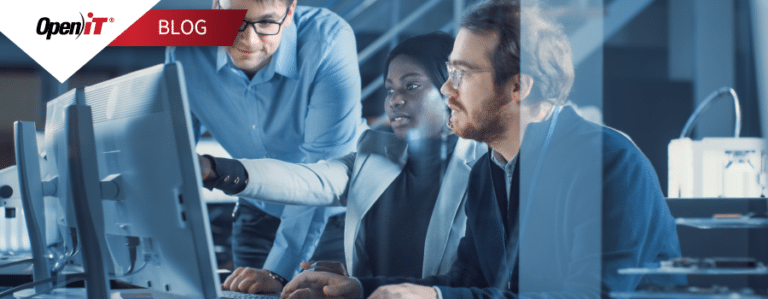Businesses have a long list of tech-enabled tools that help teams work efficiently. Due to this long list, it’s easy to overlook a particular tool, which you may not realize is far better for a specific task than the one you’re currently using.
Thus, you may be underutilizing some tools to the detriment of your company.
Your current lineup of tools could also present security risks or compliance issues, cost more than their value to the business, and hamper productivity, making them both a waste of resources and a business risk.
Since keeping up with a myriad of tools can be an extremely tedious task, you need to implement IT asset management (ITAM).
ITAM can help revolutionize the way you manage your IT assets, enabling you to:
- cut down extra costs
- increase efficiency
- use licenses optimally
- reduce security risks
- gear up for audits
- make effective purchasing decisions
This article will tackle everything you need to know about ITAM—its role in your organization, the benefits you can get from it, and how you can successfully implement it across teams.
A Rundown on IT Asset Management
IT asset management (ITAM) is the practice of organizing all aspects of your IT environment.
Part of the ITAM process involves looking into the contracts with your providers and financial and inventory data to determine your IT assets’ status and lifecycles.
If done correctly, ITAM lets you fully understand your IT infrastructure while maximizing the business value of the equipment and programs within it.
Types of IT Asset Management
As a discipline, IT asset management includes several categories to represent specific assets under them. Here are the different types of IT assets that technical teams typically handle.
Hardware
This refers to the equipment, machines, or devices used to share information or manage data. Hardware includes desktops, laptops, monitors, routers, servers, printers, scanners, copiers, processors, memory devices, keyboards, mice, power supply units, and other physical electronic devices.
Software
Software is what’s installed on the hardware. It includes all the programs that computers run to let users perform tasks, from data entry and document processing to project management and creative design, among many others.
You can either have proprietary software or third-party software. The former is built by your company’s own IT or development team, while the latter requires a license from the vendor allowing you to use the software under specific terms and conditions.
Digital
Digital IT assets form part of your company’s intellectual property. This category includes all business data you collect and store in your IT systems, such as customer information, website metrics, text and visual content, and third-party data.
Mobile
Smartphones, tablets, and other internet-enabled mobile devices belong to this category.
Mobile IT assets are considered unique, given how the concept of Bring Your Own Device (BYOD) allows employees to use personal mobile gadgets by tapping into the corporate network.
On the downside, mobile assets may pose security risks as these can also connect to public Wi-Fi outside of your office premises, which may be vulnerable to cybersecurity attacks.
Cloud
The use of cloud computing or remote servers to host your IT infrastructure, store your data, or manage your IT resources primarily defines your cloud assets.
Cloud computing can be implemented via the following methods:
- Public cloud, where the computing services are delivered over the internet for multiple organizations
- Private cloud, where you exclusively utilize the service
- Hybrid cloud, which uses both public and private cloud computing solutions
The Benefits of ITAM
IT asset management is vital for every organization, regardless of nature, type, or scale of operations.
Implementing ITAM’s strategic use of IT practices and tools can assist you in hitting your business targets.
Businesses are constantly evolving, requiring you to update your IT infrastructure and make it more agile.
Since part of ITAM involves tracking your IT inventory, it’s easy for you to see if you have the latest software version or if your hardware specifications are up to par.
Any gaps can be easily identified and resolved to improve your processes.
Through ITAM, you can also better ascertain the relevance or quality of the data gathered by your IT systems.
As you put these insights together, you can get a clear picture of how well your IT environment is built or how to design it better to support your business’s key activities.
As you keep stock of your IT assets, you’ll naturally handle the financial inventory, as well. ITAM provides you with key information about your assets’ cost-effectiveness.
Here, the goal is to ensure that buying, creating, or owning an asset offers great financial value for your business. That means it can yield ROI more quickly than it reaches its end-of-life cycle.
ITAM also promotes selecting and utilizing IT resources wisely. This is possible since ITAM includes a regular audit of all types of IT assets you currently have and how they are used in your organization.
Perhaps you have duplicate items of a particular type of software or hardware, which you weren’t aware of until you conducted the IT assets inventory. From there, you can decide if that asset can be used elsewhere or monetized in one way or another.
Regardless, you should be able to check it off your list of future purchases, further increasing your cost savings.
Technology plays a significant role in modern businesses, especially IT assets with features and functionalities relevant to your day-to-day operations.
As such, ITAM officers typically prioritize deploying IT assets that promote inter-team communications, collaborative planning, customer relationship management, inventory tracking, supply chain distribution, and the like.
Furthermore, most IT assets have life cycles that can scale alongside the growth of your business, ensuring you’re equipped with the tools you need to complete important projects.
Regulatory compliance is non-negotiable, as it aims to standardize the way companies manage customer data, engage in fair and healthy relationships with competitors and providers, and reduce overall business risks.
ITAM makes it possible for your team to address the various aspects of regulatory compliance.
This may include securing or renewing the necessary software licenses, rolling out system updates to users, or reviewing your company’s defense against cyberattacks.
ITAM Best Practices
According to Gartner, a successful ITAM implementation relies on robust processes and the right tools to enforce those practices. Here are valuable recommendations for an effective ITAM program.
Identify critical assets
A good IT environment doesn’t mean it’s filled with all sorts of hardware, software, or computing devices when you only need mission-critical ones.
For example, organizations in medical services have more use for software that lets them organize electronic patient records over a point-of-sale system, which retail companies use to process customer purchases or transactions.
Manage software and licenses in one place
If you depend on third-party software, it can be easy to lose track of how many were deployed into which business unit, which ones need to be renewed, or what the contract says you can or cannot do with them.
The complexity of this aspect of ITAM makes it a must for you to invest in license management software, as the last thing you want is to fare poorly in vendor audits and face hefty fines.
Open iT’s Enterprise-wide Monitoring solution supplies you with a complete overview of your IT assets from a single system, including their location, use cases, computational requirements, and so on.
With accurate data on hand, you can make better purchasing decisions regarding your software and licensing requirements.
Automate
ITAM best practices include automating repetitive processes, including data entry of IT contracts and hardware or software inventory.
By using automation tools, you can set up your system to send timely notifications or alerts for pending license renewals and payments so that you can avoid legal or security issues.
Implement IT chargeback
IT chargeback is a vital component of ITAM, which involves making departments accountable for their members’ asset or service requirements.
You can implement Open iT’s IT Chargeback program to ensure your company’s IT spending is managed well while building your employees’ cost-saving perspective.
Since the cost of each asset is charged to the concerned department via advanced invoicing solutions, it’s easy to audit if a particular unit’s IT budget allocation is justifiable based on the functions they perform.
Exploit your data
Here, the goal is to make your ITAM data readily available to members of your organization, such as those at the service desk, through data integration capabilities.
Service desk agents should have access to remote servers, enabling them to pull up data needed to process service requests of business users.
Gather feedback from end-users
Establishing appropriate feedback channels is the only way system developers and designers can learn what works and what doesn’t within your IT environment.
Conduct surveys or interviews with ITAM end-users regarding any asset additions, modifications, or disposals they require to improve your systems and processes.
Set Up Your Business for Success Through ITAM
Technology drives today’s businesses, making it essential to track and manage all your hardware, software, virtual, and non-IT assets from one place.
You can create a solid plan and a streamlined process to achieve this goal through IT asset management.
If you’re looking for expert solutions on how to be efficient in managing engineering software licenses, Open iT can help. Schedule a demo to learn more.











